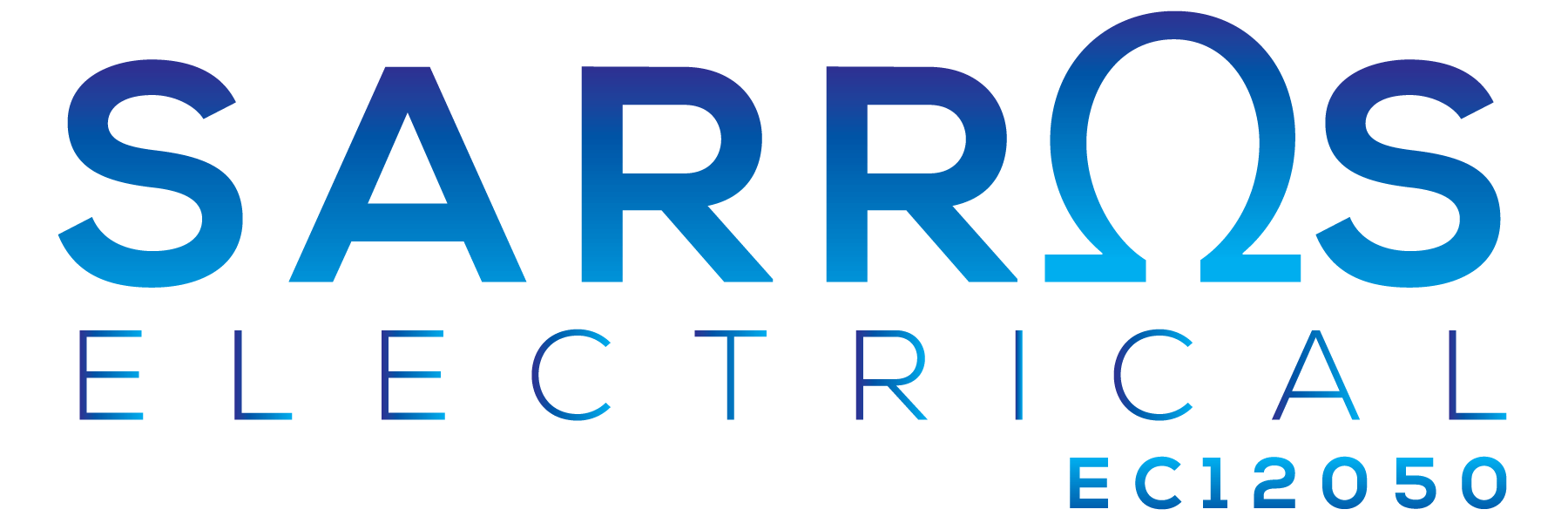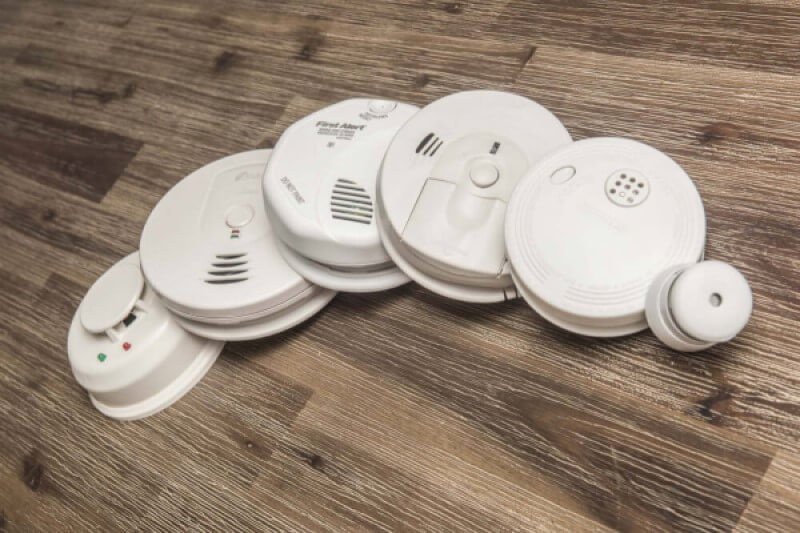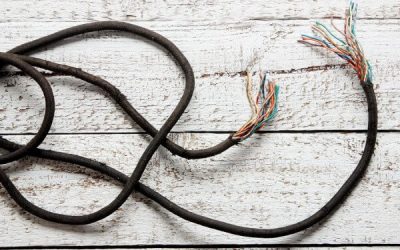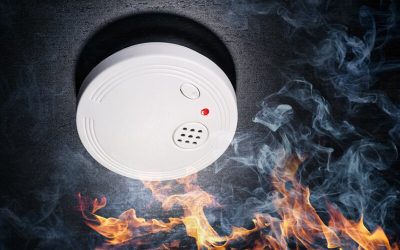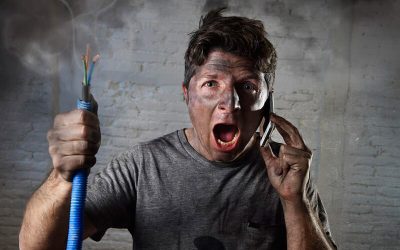Smoke alarms became a common household item in the 1970’s, and since then they have saved countless lives. In fact, early fire detection has reduced the number of house fires by over 50%! Sarros Electrical are experts in smoke alarm installation throughout Western Australia, keeping Aussie families safe!
So, how do these miracle devices actually work? What makes them so effective at saving lives?
Let’s find out about the 2 most common types of smoke detectors.
Smoke alarm type 1: Photoelectric detectors
The word photoelectric comes from the Greek word phot meaning light, and electric, obviously anything relating to electricity. So how do they work together?
Imagine the inside of a smoke alarm being like a long rectangular room. A beam of light continually shines across the room, uninterrupted.
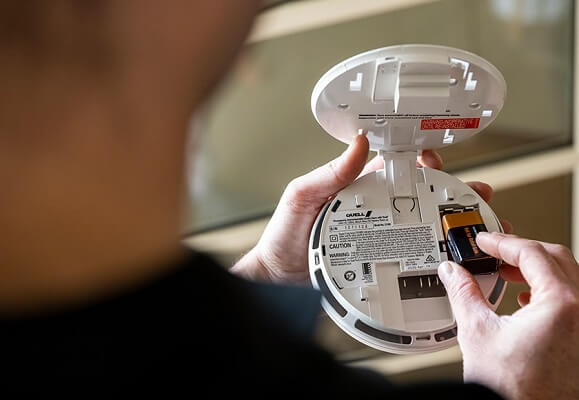
When the air is clear, the light passes straight through. This is what the inside of a photoelectric detector looks like normally.
But, if a lot of dust and smoke enters this rectangular room, the path of these horizontal traveling beams is interrupted, some beams of light will bounce off the smoke and dust into the roof and floor.
When the sensor on the floor detects light, it turns it into an electrical signal.
The more smoke in the air, the more the light hits the electrical sensor. After a certain amount of light hits the floor sensor, the smoke alarm is triggered and warns anyone in the vicinity.
A more thorough explanation on how this works can be found here.
Smoke alarm type 2: Ionization detector
These detectors rely on the radioactive properties of certain materials.
However, there is no need to panic as the levels of radioactivity involved are extremely low and only pose a slight risk over a few millimeters, far out of reach of you and your family.
Furthermore, the alarm lining itself prevents any radiation from escaping, so there is no harm to you or your family.
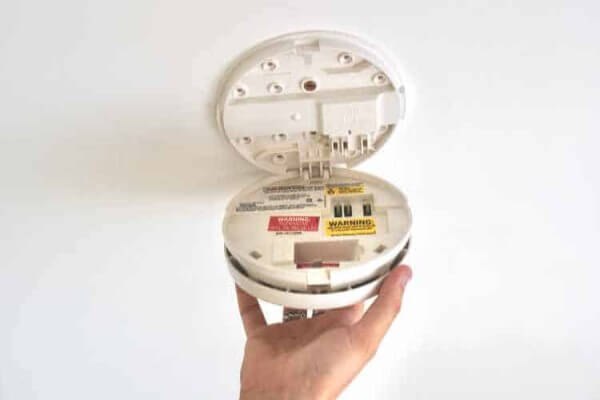
To put it simply, Ionization detectors consist of two plates, positive and negative.
The radioactive materials within the detector emit a small amount of energy that charges the surrounding air positively or negatively.
As a result, the charged air moves towards either plate creating a small but consistent electric current.
Although the electrical flow is generally steady, fires and smoke emit additional particles that interrupt this flow. When the detector detects fluctuations in the current passing through it, it triggers the alarm.
A more thorough explanation on how this works can be found here.
A detailed look at photoelectric detectors
Photoelectric detectors, which are also known as optical smoke detectors are generally built in one of two ways.
One type of photoelectric sensor triggers the smoke alarm when it receives a light signal bouncing off the smoke. The other type of photoelectric sensor triggers the alarm when the light signal it constantly receives is interrupted (by smoke).
Typically, the inside of a smoke alarm is less like a rectangular room, but closer to a T-shaped corridor.
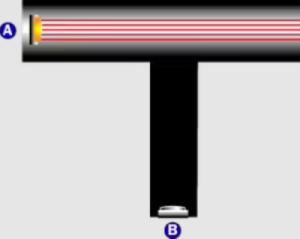
The light enters from the top left of the T (A), and any smoke particulates enter in from the top right of the T.
The bottom of the stem of the T contains the detector (B). Once the light has been scattered by the smoke particulates and flows down into the detector, then the alarm goes off.
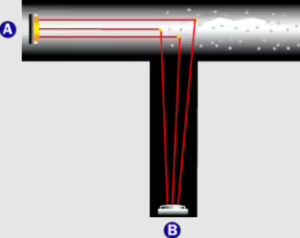
Each type of detector, both photoelectric and ionization according to all studies are effective at alerting individuals of a fire.
However, photoelectric is especially effective against fires that begin with a long period of smoldering known as “smoldering fires.”
Ionization on the other hand provides the fastest response to flaming fires, one’s with larger flames and higher temperatures.
To provide the best protection for your family it’s generally recommended that you have a combination of both types in your house where possible.
Newer technologies have allowed for the creation of detectors that contain both types within one detector!
Did you know?
Fire sensors were developed from technology NASA uses to enhance photos of distant planets.
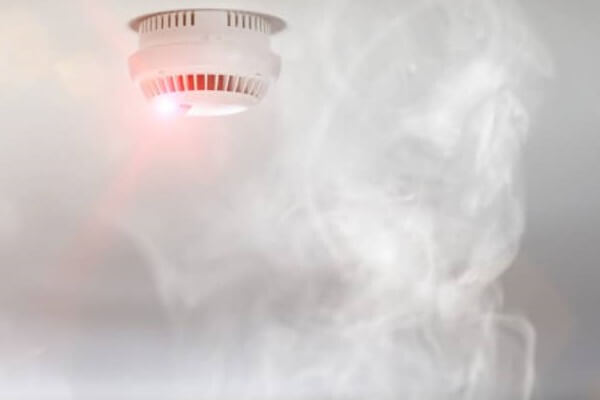
A detailed look at ionization detectors
Ionization detectors are the smoke alarms found in 90% of households.
Although the material used is often radioactive Amercium-241, each detector only contains roughly 1/5000th of a gram, and the emitted radiation is weak alpha radiation, which struggles to pierce even a piece of paper let alone your skin.
However, this chemical will constantly spit out a set amount of radiation per second, which will knock an electron off an Oxygen or Nitrogen atom, causing them to have a residual positive charge and move toward the negative plates.
The residual displaced electron will flow to the positive side and a constant measurable current is created.
This method of detection was first developed by Swiss physicist, Ernest Meili in 1939 in an effort to detect explosive gasses in mines before miners were sent in.
The process was refined for generating cathode tubes with high sensitivity. The technology was then passed on to larger companies such as NASA for the detection of distant objects in the night sky.
Originally these alarms sold for the equivalent of just under $1000 in today’s money, but due to advancements in processing the price fortunately is now a fraction of the original price.
Did you know?
The first smoke alarms sold for the equivalent of just under $1000 in today’s money!
As previously mentioned, these alarms react faster to flaming fires, but this sensitivity makes them candidates for false alarms, and, as such people tend to remove the battery and lose all safety benefits provided by this alarm.
Where should I place smoke alarms?
There are standard rules for where smoke alarms should be placed in a house, however, these are subject to change depending on the state, size of your house, age of your house, etc. for more information please click here.
Conclusion
As you can see from the above explanations, both devices use a similar method of detection, they both generate a constant environment, which when interrupted by smoke, triggers an alarm.
For the photoelectric detector, it’s a constant and uninterrupted light beam. For the ionization detector, it’s a consistent current within a circuit generated by nearby radiation.
Only when these consistent environments have been affected by smoke, soot, and flames, will the alarm sound.
In short, your alarms are always ready to warn you. Some alarms run on battery, so you will need to check them from time to time, those that are plugged into the main grid, however, should always be good to go. Nowadays, in Western Australia, smoke alarms need to be connected to mains with a battery back up.
Just make sure smoke alarms are installed by a licensed electrician!
Regardless of which alarm you choose, always go with a reputable brand, and don’t be reluctant to spend a little bit more on something that your life depends on.
Sarros Electrical is Western Australia’s electrician of choice. We always prioritize your safety and complete satisfaction whilst maintaining competitive pricing.
For smoke alarm installation, simply give us a call on (08) 9226 7900 today.
